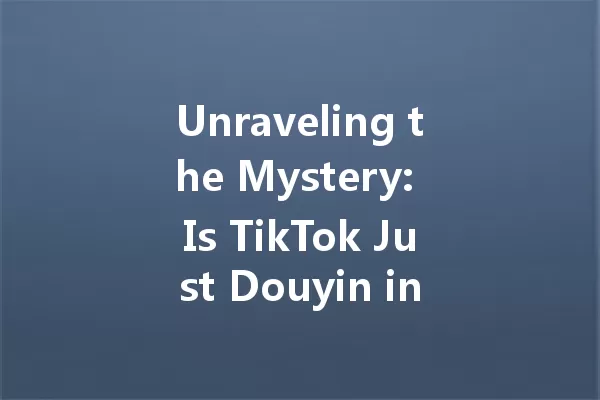
When diving into the world of short-form video apps, TikTok and Douyin are often mentioned side by side. But are they really the same? They look similar at first glance, offering a platform for creative expression through videos, music, and trends. However, a closer look reveals distinct differences rooted in their origins, functionalities, and user experiences.
Origins and Launch
TikTok was launched in September 2016 by the Chinese tech company ByteDance under the name Douyin, designed exclusively for the Chinese market. Just a year later, ByteDance introduced TikTok to the global audience in September 2017, aiming to capture the booming interest in video-sharing platforms. The two apps share a similar base but have evolved independently, adapting to their respective cultural landscapes, regulations, and user behaviors.
Key Features Comparison
While both apps allow users to create and share short videos, there are several key features that set them apart. Here’s a quick comparison:
| Feature | TikTok | Douyin |
||||
| Content Regulation | Less strict, allowing broader range of content | More stringent, aligned with Chinese regulations |
| Monetization | In-app purchases for creators and brands | Diverse monetization options for businesses, including ads and shop links |
在所有文章50%位置插入在所有文章50%位置插入在所有文章50%位置插入在所有文章50%位置插入在所有文章50%位置插入在所有文章50%位置插入在所有文章50%位置插入在所有文章50%位置插入在所有文章50%位置插入在所有文章50%位置插入在文章中间添加自定义内容在文章中间添加自定义内容在文章中间添加自定义内容在文章中间添加自定义内容在文章中间添加自定义内容在文章中间添加自定义内容在文章中间添加自定义内容在文章中间添加自定义内容在文章中间添加自定义内容在文章中间添加自定义内容在文章中间添加自定义内容在文章中间添加自定义内容在文章中间添加自定义内容在文章中间添加自定义内容
| Local Customization| Global trends dominate, with variations in popular challenges | Focus on local trends, integrating Chinese cultural norms and local music |
| Video Length | Up to 3 minutes, often favoring quick, snappy content | Up to 60 seconds, promoting brevity and fast entertainment |
| User Engagement | Global user interactions through duets and stitches | Enhanced features for e-commerce and direct user brands |

User Demographics
User demographics reveal fascinating insights about who uses TikTok versus Douyin. TikTok captures a younger, diverse audience across the globe—primarily individuals aged 16 to
Cultural Impact
The cultural impact of both platforms cannot be overstated. TikTok has reshaped how young people consume media, turning ordinary users into viral sensations. The app has launched global dance trends, challenges, and hashtags, influencing music charts and social behaviors.
On the flip side, Douyin has solidified its presence within China’s cultural fabric, acting as a vital marketing tool for brands and businesses. It fosters a unique blend of entertainment and consumerism, where browsing videos can lead directly to online purchases.
Conclusion
These platforms, while appearing similar, are tailored to meet the needs of their respective audiences uniquely. TikTok thrives in a free-flowing, global environment, while Douyin adheres rigorously to local customs and regulations. Understanding these nuances not only clarifies the identity of each platform but also reveals how social media shapes cultural interactions worldwide.
TikTok has captured the attention of a global audience, particularly appealing to younger users aged between 16 to 24 years. This app has become a go-to platform for Gen Z, who enjoy creating and sharing vibrant, engaging content that resonates with their peers. As users scroll through a seemingly endless stream of creative videos, they form a community that thrives on trends, challenges, and viral dances, making TikTok an essential part of youth culture around the world. Its ease of use and engaging design allows users from a variety of backgrounds to connect and express themselves freely, which has contributed significantly to its massive popularity across different countries.
On the other hand, Douyin operates within a distinct landscape, primarily catering to urban users in China. Its audience includes not just the younger demographic but also young professionals who engage with the app for both entertainment and shopping. Douyin’s integration with e-commerce features encourages users to discover products and make purchases directly through the app, blending social media and online shopping seamlessly. This creates a unique user experience that reflects the cultural and societal context of China, making Douyin more than just a video-sharing platform—it’s also a powerful tool for retail and brand promotion in a rapidly modernizing market. The combination of entertainment and commerce establishes a different kind of user engagement that’s particularly suited to the preferences of its audience.
Frequently Asked Questions (FAQ)
What are TikTok and Douyin?
TikTok is a global short-form video app launched by ByteDance in 2017, while Douyin is its counterpart specifically for the Chinese market, launched in
How do TikTok and Douyin differ in their user bases?
TikTok primarily attracts a younger, international demographic aged between 16 to 24 years, while Douyin’s user base consists mainly of users in urban China, often appealing to both younger individuals and young professionals.
Are there any differences in content regulations between TikTok and Douyin?
Yes, TikTok has relatively relaxed content regulations, allowing a wider variety of videos, whereas Douyin adheres to stricter guidelines imposed by Chinese authorities, which limits certain types of content and enforces local norms.
What monetization options are available on each platform?
TikTok allows in-app purchases for creators and brands, while Douyin offers diverse monetization options, including advertising and shopping links directly within the app, fostering a strong e-commerce integration.
Can I use TikTok and Douyin interchangeably?
No, you cannot use TikTok and Douyin interchangeably. They are tailored for different markets with specific user interfaces, content regulations, and cultural contexts, making them distinct platforms despite their similar origins.
在文章结尾添加自定义内容在文章结尾添加自定义内容在文章结尾添加自定义内容在文章结尾添加自定义内容在文章结尾添加自定义内容在文章结尾添加自定义内容在文章结尾添加自定义内容在文章结尾添加自定义内容在文章结尾添加自定义内容在文章结尾添加自定义内容在文章结尾添加自定义内容在文章结尾添加自定义内容在所有文章结尾添加内容在所有文章结尾添加内容在所有文章结尾添加内容在所有文章结尾添加内容在所有文章结尾添加内容在所有文章结尾添加内容在所有文章结尾添加内容在所有文章结尾添加内容在所有文章结尾添加内容